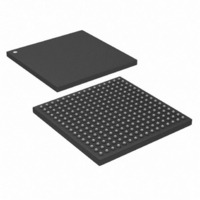DS33X81+ Maxim Integrated Products, DS33X81+ Datasheet - Page 59

DS33X81+
Manufacturer Part Number
DS33X81+
Description
IC MAPPING ETHERNET 256CSBGA
Manufacturer
Maxim Integrated Products
Datasheet
1.DS33X11.pdf
(375 pages)
Specifications of DS33X81+
Applications
Data Transport
Interface
Parallel/Serial
Voltage - Supply
1.8V, 2.5V, 3.3V
Package / Case
256-CSBGA
Mounting Type
Surface Mount
Lead Free Status / RoHS Status
Lead free / RoHS Compliant
- Current page: 59 of 375
- Download datasheet (3Mb)
________________________________________________ DS33X162/X161/X82/X81/X42/X41/X11/W41/W11
8.14.1 Full Duplex Flow control
Automatic flow control is governed by the LAN Queue high watermark in AR.LQW, and is enabled per LAN Queue
in the SU.LQXPC register. This allows the user to enable or disable flow control for each of the four mapped
PCP/DSCP priorities. When the LAN queue threshold is exceeded on which flow control is enabled, the device will
send a pause frame with the timer value programmed in SU.MACFCR.PT[15:0] when in full duplex, or a jamming
signal in half duplex. More information on configuring the queues, see Section 8.9.3. Also see the SU.MACFCR
register definition for recommended flow control settings.
The pause frame causes the distant transmitter to “pause for a time” before starting transmission again. The device
will send a pause frame as the queue has crossed the threshold defined in AR.LQW. The pause control frame is
retransmitted every 16.4us, 164us, or 1.64ms, depending on the settings in SU.MACFCR.PLT. The receive queue
could keep growing if the round trip delay is greater than the Pause time. Pause control will only take care of
temporary congestion it does not take care of systems where the traffic throughput is too high for the queue sizes
selected. If the flow control is not effective the receive queue will eventually overflow. This is indicated in
SU.LIQOS. If the receive queue is overflowed any new frames will not be received until the overflow condition is
corrected..
The user has the option of not enabling automatic flow control. In this case the thresholds and corresponding
interrupt mechanism to send pause frame by writing to the FCB bit in the MAC flow control register SU.MACFCR.
This allows the user to set not only the watermarks but also to decide when to send a pause frame or not based on
watermark crossings.
On the receive side the user has control over whether to respond to the pause frame sent by the distant end
(SU.MACFCR.RFE bit). On the Transmit queue the user has the option of setting high and low thresholds and
corresponding interrupts. There is no automatic flow control mechanism for data received from the Serial
side waiting for transmission over the Ethernet interface during times of heavy Ethernet congestion.
8.14.2 Half Duplex Flow control
Half duplex flow control functions like Full Duplex flow control, but a jamming sequence is used to exert
backpressure on the transmitting node rather than Pause control frames. The receiving node jams the first 4 bytes
of a frame that are received from the MAC in order to cause a collision detection at the distant end. In both
100Mbps and 10Mbps MII/RMII modes, 4 bytes are jammed upon reception of a new frame. Note that the jamming
mechanism does not jam the frame that is being received during the watermark crossing, but will wait to jam the
next frame after the AR.LQW is crossed. If the queue remains above the threshold, received frames will continue
to be jammed. This jam sequence is stopped when the queue falls below the threshold in AR.LQW.
Rev: 063008
59 of 375
Related parts for DS33X81+
Image
Part Number
Description
Manufacturer
Datasheet
Request
R

Part Number:
Description:
MAX7528KCWPMaxim Integrated Products [CMOS Dual 8-Bit Buffered Multiplying DACs]
Manufacturer:
Maxim Integrated Products
Datasheet:

Part Number:
Description:
Single +5V, fully integrated, 1.25Gbps laser diode driver.
Manufacturer:
Maxim Integrated Products
Datasheet:

Part Number:
Description:
Single +5V, fully integrated, 155Mbps laser diode driver.
Manufacturer:
Maxim Integrated Products
Datasheet:

Part Number:
Description:
VRD11/VRD10, K8 Rev F 2/3/4-Phase PWM Controllers with Integrated Dual MOSFET Drivers
Manufacturer:
Maxim Integrated Products
Datasheet:

Part Number:
Description:
Highly Integrated Level 2 SMBus Battery Chargers
Manufacturer:
Maxim Integrated Products
Datasheet:

Part Number:
Description:
Current Monitor and Accumulator with Integrated Sense Resistor; ; Temperature Range: -40°C to +85°C
Manufacturer:
Maxim Integrated Products

Part Number:
Description:
TSSOP 14/A�/RS-485 Transceivers with Integrated 100O/120O Termination Resis
Manufacturer:
Maxim Integrated Products

Part Number:
Description:
TSSOP 14/A�/RS-485 Transceivers with Integrated 100O/120O Termination Resis
Manufacturer:
Maxim Integrated Products

Part Number:
Description:
QFN 16/A�/AC-DC and DC-DC Peak-Current-Mode Converters with Integrated Step
Manufacturer:
Maxim Integrated Products

Part Number:
Description:
TDFN/A/65V, 1A, 600KHZ, SYNCHRONOUS STEP-DOWN REGULATOR WITH INTEGRATED SWI
Manufacturer:
Maxim Integrated Products

Part Number:
Description:
Integrated Temperature Controller f
Manufacturer:
Maxim Integrated Products

Part Number:
Description:
SOT23-6/I�/45MHz to 650MHz, Integrated IF VCOs with Differential Output
Manufacturer:
Maxim Integrated Products

Part Number:
Description:
SOT23-6/I�/45MHz to 650MHz, Integrated IF VCOs with Differential Output
Manufacturer:
Maxim Integrated Products

Part Number:
Description:
EVALUATION KIT/2.4GHZ TO 2.5GHZ 802.11G/B RF TRANSCEIVER WITH INTEGRATED PA
Manufacturer:
Maxim Integrated Products

Part Number:
Description:
QFN/E/DUAL PCIE/SATA HIGH SPEED SWITCH WITH INTEGRATED BIAS RESISTOR
Manufacturer:
Maxim Integrated Products
Datasheet:










